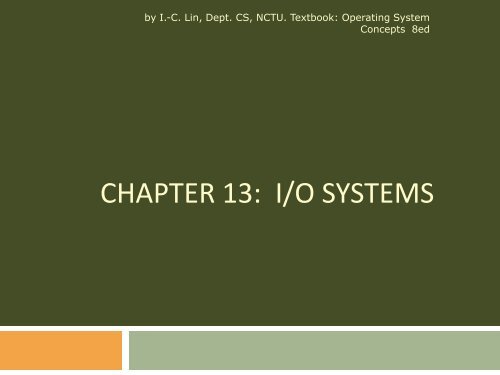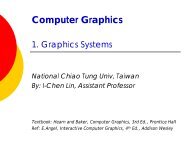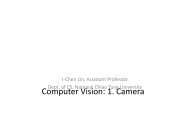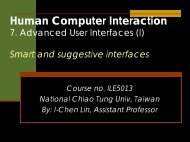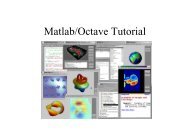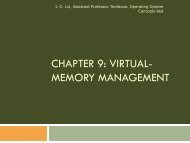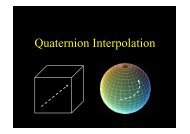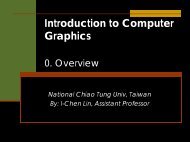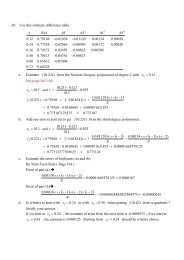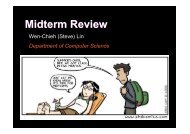CHAPTER 13: I/O SYSTEMS
CHAPTER 13: I/O SYSTEMS
CHAPTER 13: I/O SYSTEMS
You also want an ePaper? Increase the reach of your titles
YUMPU automatically turns print PDFs into web optimized ePapers that Google loves.
y I.-C. Lin, Dept. CS, NCTU. Textbook: Operating System<br />
Concepts 8ed<br />
<strong>CHAPTER</strong> <strong>13</strong>: I/O <strong>SYSTEMS</strong>
Chapter <strong>13</strong>: I/O Systems<br />
I/O Hardware<br />
Application I/O Interface<br />
Kernel I/O Subsystem<br />
Transforming I/O Requests to Hardware Operations<br />
Streams<br />
Performance
Objectives<br />
Explore the structure of an operating system’s I/O<br />
subsystem<br />
Discuss the principles of I/O hardware and its<br />
complexity<br />
Provide details of the performance aspects of I/O<br />
hardware and software
I/O Hardware<br />
Incredible variety of I/O devices<br />
Common concepts<br />
Port<br />
Bus (daisy chain or shared direct access)<br />
Controller (host adapter)<br />
I/O instructions control devices<br />
Devices have addresses, used by<br />
Direct I/O instructions<br />
Memory-mapped I/O
A Typical PC Bus Structure
I/O Transfer<br />
<br />
I/O instruction<br />
Specify a byte or word to I/O port address.<br />
Trigger bus lines to move bits into/out of device register.<br />
<br />
Memory map I/O<br />
Map the device control registers as address space of the processor.<br />
E.g. in graphics controller, memory-mapped methods can reduce<br />
millions of I/O instructions.<br />
Have to take care about access of invalid memory addresses.
Registers of I/O ports<br />
<br />
<br />
<br />
<br />
Data-in register<br />
Read by the host.<br />
Data-out register<br />
Written by the host.<br />
Status register (bits)<br />
Read by the host.<br />
Completeness, error, availability, etc.<br />
Control register<br />
Written by the host.<br />
Issue commands or change the device mode.
Device I/O Port Locations on PCs (partial)
Polling<br />
<br />
<br />
Determines state of device<br />
command-ready, busy, error.<br />
Busy-wait cycle to wait for I/O from device<br />
1. The host repeatedly reads the busy bit until it is clear.<br />
2. The host set the write bit in the command register and data to data-out<br />
register.<br />
3. The host sets the command-ready bits.<br />
4. The controller notices that the command-ready bits is set; it sets the<br />
busy bits.<br />
5. The controller reads the command and data-out registers and does the<br />
I/O.<br />
6. The controller clears the command-ready bit and the error bits to<br />
indicate the I/O success and clears the busy bit to indicate that it’s<br />
finished
Interrupts<br />
<br />
CPU Interrupt-request line triggered by I/O device<br />
<br />
System save the status and jump to interrupt handler at a fixed address in<br />
memory.<br />
Interrupt vector table: reduce the need to search all possible source.<br />
Interrupt chaining: for systems with more devices.<br />
<br />
Maskable to ignore or delay some interrupts<br />
<br />
Interrupt vector to dispatch interrupt to correct handler<br />
<br />
<br />
Based on priority<br />
Some nonmaskable<br />
<br />
Interrupt mechanism also used for exceptions
Interrupt and exceptions<br />
<br />
Privileged kernel routines can be implemented by software<br />
interrupts (trap)<br />
Page faults<br />
• The interrupt suspends the current process and the page-fault handler<br />
fetches the page and resume the process.<br />
System calls<br />
• Save the user process status, switches to supervisor modes and dispatches<br />
to kernel routines for the requested service.
Interrupt-Driven I/O Cycle
Intel Pentium Processor Event-Vector Table
Direct Memory Access<br />
<br />
<br />
<br />
<br />
Used to avoid programmed I/O for large data movement<br />
Requires DMA controller<br />
Bypasses CPU to transfer data directly between I/O device and<br />
memory<br />
DMA through DMA-request and DMA-acknowledge wires.<br />
CPU writes the address of source and destinations and byte numbers to<br />
DMA controller.<br />
Device controller signals DMA-request when a word is available.<br />
DMA controller seize the memory bus and place the desired address on<br />
the memory address wires and signals DMA-acknowledge.<br />
Device controller than transfers the word to memory and clear DMArequest<br />
signal.
Six Step Process to Perform DMA Transfer
Application I/O Interface<br />
<br />
<br />
<br />
I/O system calls encapsulate device behaviors in generic<br />
classes<br />
Device-driver layer hides differences among I/O controllers<br />
from kernel<br />
Devices vary in many dimensions<br />
Character-stream or block<br />
Sequential or random-access<br />
Sharable or dedicated<br />
Speed of operation<br />
read-write, read only, or write only
A Kernel I/O Structure
Characteristics of I/O Devices
Block and Character Devices<br />
<br />
Block devices include disk drives<br />
Commands include read, write, seek<br />
• Raw I/O: handled by applications<br />
• File-system access: handled by OS.<br />
Memory-mapped file access possible<br />
<br />
Character devices include keyboards, mice, serial ports<br />
Commands include get, put<br />
Libraries layered on top allow buffering and line editing.
Network Devices<br />
<br />
Varying enough from block and character to have own interface<br />
<br />
Unix and Windows NT/9x/2000 include socket interface<br />
<br />
<br />
Separates network protocol from network operation<br />
Includes select functionality<br />
<br />
Approaches vary widely (pipes, FIFOs, streams, queues, mailboxes)
Clocks and Timers<br />
<br />
Provide current time, elapsed time, timer<br />
<br />
Programmable interval timer used for timings, periodic<br />
interrupts<br />
<br />
Support more timer requests than the number of timer by<br />
“virtual clocks”.<br />
Sort the request in the earliest-time-first order
Blocking and Nonblocking I/O<br />
<br />
Blocking - process suspended until I/O completed<br />
Easy to use and understand<br />
Insufficient for some needs<br />
<br />
Nonblocking - I/O call returns as quick as available<br />
User interface, data copy (buffered I/O)<br />
Implemented via multi-threading<br />
Returns quickly with count of bytes read or written<br />
<br />
Asynchronous - process runs while I/O executes<br />
Difficult to use<br />
I/O subsystem signals process when I/O completed
Two I/O Methods<br />
Synchronous<br />
Asynchronous<br />
(a) Synchronous and (b) asynchronous I/O
Kernel I/O Subsystem<br />
<br />
Kernels provides: scheduling, buffering, caching, spooling,<br />
error handling, etc.<br />
<br />
Scheduling<br />
Some I/O request ordering via per-device queue<br />
Some OSs try fairness<br />
Device-status Table
Kernel I/O Subsystem (cont.)<br />
<br />
Buffering - store data in memory while transferring between<br />
devices<br />
To cope with device speed mismatch<br />
To cope with device transfer size mismatch<br />
To maintain “copy semantics” : e.g. guarantee write() to buffer instead of<br />
the disk
Kernel I/O Subsystem (cont.)<br />
<br />
<br />
<br />
Caching - fast memory holding copy of data<br />
Always just a copy<br />
Key to performance<br />
Different policy for update: write-through, delayed write, etc.<br />
Spooling - hold output for devices<br />
<br />
if a device cannot accept interleaved data streams, e.g. printer, tape<br />
drives.<br />
Each application’s output is spooled to a separate disk file.<br />
Error Handling<br />
OS can recover from disk read, device unavailable, transient write<br />
failures<br />
Most return an error number or code when I/O request fails<br />
System error logs hold problem reports
I/O Protection<br />
<br />
User process may accidentally or purposefully attempt to<br />
disrupt normal operation via illegal I/O instructions<br />
All I/O instructions defined to be privileged<br />
I/O must be performed via system calls<br />
• Memory-mapped and I/O port memory locations must be protected too<br />
• Efficiency vs. protection: memory-mapped graphics controller memory.
Use of a System Call to Perform I/O
Kernel Data Structures<br />
<br />
Kernel keeps state info for I/O components, including open<br />
file tables, network connections, character device state<br />
<br />
Many, many complex data structures to track buffers,<br />
memory allocation, “dirty” blocks<br />
<br />
Some use object-oriented methods and message passing to<br />
implement I/O
UNIX I/O Kernel Structure
I/O Requests to Hardware Operations<br />
<br />
Consider reading a file from disk for a process:<br />
Check the parameters’ correctness.<br />
Check whether the data are available in the buffer cache.<br />
If it is not available, place the user process to the device’s waiting queue.<br />
I/O subsystem sends request to the device driver.<br />
The device driver allocates kernel buffer space and send commands to<br />
the device controller’s registers.<br />
The device controller operates the data transfer.<br />
Polling or interrupts for checking data completion. (interrupt handler<br />
signal the corresponding device driver.)<br />
The device driver signals the I/O subsystem for later data transferring to<br />
the requesting process.<br />
Moving the requesting process to the ready queue.
Life Cycle of An I/O Request
STREAMS<br />
<br />
<br />
STREAM – a full-duplex<br />
communication channel between a<br />
user-level process and a device in Unix<br />
System V and beyond.<br />
A STREAM consists of:<br />
- STREAM head interfaces with the user process<br />
- driver end interfaces with the device<br />
- zero or more STREAM modules between them.<br />
<br />
<br />
Each module contains a read queue<br />
and a write queue<br />
Message passing is used to<br />
communicate between queues
Performance<br />
I/O a major factor in system performance:<br />
Demands CPU to execute device driver, kernel I/O<br />
code<br />
Context switches due to interrupts<br />
Data copying<br />
Network traffic especially stressful
Intercomputer Communications
Improving Performance<br />
Reduce number of context switches<br />
Reduce data copying<br />
Reduce interrupts by using large transfers, smart<br />
controllers, polling<br />
Use DMA<br />
Balance CPU, memory, bus, and I/O performance for<br />
highest throughput
Device-Functionality Progression


